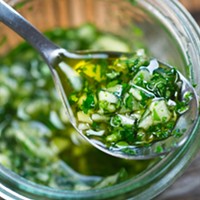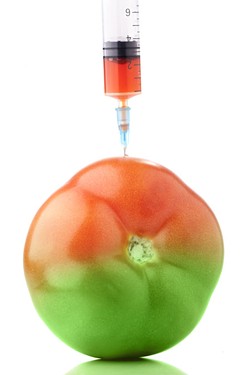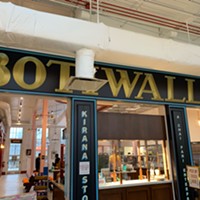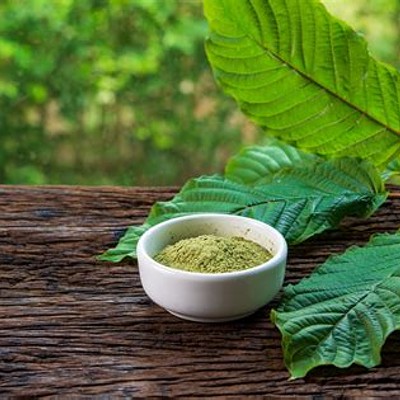In case you missed it, there has been an interesting discussion about genetically modified food over at Grist.org. It began with a series of posts by Nathanael Johnson, in which he dissected, in impressively neutral and skeptical fashion, most of the arguments for or against GM food that you've ever heard.
Johnson's posts managed to draw attention and respect from voices on all sides of the issue. By way of his quest to take no side, he managed to get on a lot of peoples' good sides. The comment section was, at times, somewhat civil and well-behaved, no minor feat among GMO pundits, and there were even examples of constructive debate.
After six months of researching and posting, Johnson came to the conclusion that GMOs are neither as scary as many GM food haters claim, nor as world-saving as claimed by supporters of GM food. In an attempt to put the discussion to bed, he wrote, in what he thought was the series' capstone, "The most astonishing thing about the vicious public brawl over GMOs, is that the stakes are so low."
All of a sudden, folks respectfully had beef with Johnson. Two responses were published at Grist, one by Mother Jones food columnist (and former Grist food writer) Tom Philpott, a longtime critic of GM food, and one by Ramez Naam, author of The Infinite Resource: The Power of Ideas on a Finite Planet.
Philpott argued that GMOs do matter, because they are a load-bearing pillar of a misguided agriculture system, while Naam wrote that GMOs matter because they can, and already do, benefit people and the environment, not just corporations and factory farms.
According to Philpott, most GMOs have been used to sell pesticides and herbicides. He called the vast majority of GMOs currently on the market, "an appendage of the pesticide industry, which has dominated the technology from the start."
Naam, who supports GM food and is also a proponent of "sensible labeling," wrote that GM crops have more impact in poor countries than rich ones. He discussed genetically modified cotton in India as an example of how GM crops can help boost the incomes of small farmers.
While Philpott and Naam inhabit opposing camps on the GMO issue, their arguments are not mutually exclusive.
If Naam is right and GM crops can be a force for good, it does not derail Philpott's assessment of how GMOs have impacted agriculture to date.
If Philpott is right, and GMOs have done little more than boost yields of corn and soy while selling more chemicals, it doesn't mean that the technology shows no promise.
If they're both right, their arguments could define an important chunk of common ground between both sides, on the playing field that Johnson leveled.
My take on all this is that the conversation can continue, respectfully and productively, if some basic compromises are made among people on both sides of the issue.
Skeptics of GM food should come to grips with the fact that the act of genetic manipulation is itself not unholy.
As it is, few GMO haters would refuse medicine made with assistance from GM bacteria, like insulin, or a blood clot thinner used to treat a stroke. As GMOs have proven useful in medicine, they could also be useful in agriculture.
By the same token, proponents of GM foods should remember that for most skeptics of GM food, the bare act of genetic manipulation isn't even the issue. It's the process by which the technology has been rolled out that's pissing them off. In many ways, the script is playing out according to old fears, and there seems little public recourse available.
The epitome of this power imbalance, of course, is Monsanto, simultaneously the world's largest biotech corporation, seed company, organic seed company, and one of the world's largest pesticide companies. That's a ridiculous concentration of power. A profitable concentration, if you're on board, as genetically modified corn and soy covers about half of all U.S. cropland. But given we already grow way more corn and soy than we should, how is this a good thing?
The Rainbow papaya in Hawaii is an example of a GM food that resulted from a more confidence-inspiring process: a collaboration between farmers and a university, to solve a serious problem. An outbreak of ringspot virus was destroying Hawaii's small papaya industry. A resistant papaya was engineered, and the problem appears to have been solved with little evident downside.
There is now an effort underway to use genetic modification to save Florida's orange orchards, which are threatened by the greening virus.
Bananas and chocolate, as well as other beloved and economically important crops, are susceptible to viruses as well, with many agricultural regions having already lost their ability to produce these crops. GMO haters might want to do a gut check by asking themselves if they would forgo GM chocolate if it was the last chocolate on earth.
And those who believe that all GM skeptics are being paranoid should remember that there is nothing inherently safe about introducing GM plants into people and the environment. If not tested and regulated appropriately, there will be problems.
After Philpott's and Naam's rebukes of his "GMOs don't matter" conclusion, Johnson posted a response of his own, beneath the headline: "OK, GMOs matter, but the noisy fight over them is a distraction." He acknowledges that there are problems with GM foods, but thinks they have been overblown and are solvable.
The battle over GM food has become a proxy for a philosophical debate about the appropriate places of science and capitalism, and their powerful union, in our lives. This is an important, ongoing discussion to have. But it's a separate discussion, even if GM crops offer many cases in point.
The potential benefits and risks of GM food lie in the processes by which this neutral technology is deployed. So let's focus on these processes, as part of focusing on how best to solve the problems that most need solving.
Ari LeVaux writes Flash in the Pan, a syndicated weekly food column that has appeared in more than 50 newspapers in 21 states. Learn more at flashinthepan.net.
Speaking of...
-

No One Knows How to Cook Radicchio
Oct 10, 2018 -

The Real Way to Ramen
Aug 29, 2018 -

Dandelion Don't Tell No Lies
May 30, 2018 - More »
Latest in Food & Drink Features
More by Ari LeVaux
-

No One Knows How to Cook Radicchio
Oct 10, 2018 -

Hurry, Hurry, Chimichurri
Sep 19, 2018 -

The Real Way to Ramen
Aug 29, 2018 - More »
Calendar
-

Aria Tuscan Grill Featuring Allegrini - Charlotte Wine + Food Week @ Aria Tuscan Grill
-

Angeline’s Featuring Sciandri Family Vineyards @ Angeline's
-

Charlotte Wine + Food Week Presented by Truist @ Charlotte, NC
-

Cakeable Cafe Grand Opening @ Cakeable Cafe
-

Haw River Wine Tasting @ Carolina Beer Temple.
-
Dorie Greenspan's Tiramisu Cake
This layered cake is definitely a "pick-me-up" with a little booze and caffeine.
-
Good Eats
The following is Creative Loafing's bite-sized guide to restaurants in the Charlotte area. We hope this reliable reference will serve as a quality source to aid in your dining pleasure. The dollar signs at the end of each item are indicative of the
-
Authentic New York-style Bagels Come to South End 1
Poppy's expands its empire












